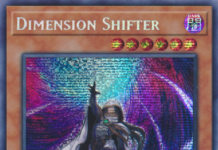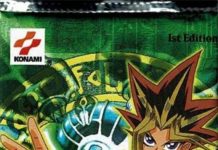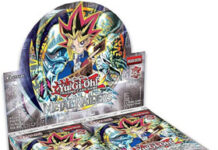How long does it typically take for a Video Game promo from a Yu-Gi-Oh game to get a reprint? Well, I did the research and got the answers. Hello Pojo Readers, Crunch$G back with something different this time around. When Bill came to me and asked me about the video game promos for the Legacy of the Duelist: Link Evolution game, it made me somewhat curious as to how long it takes for a video game promo to receive a reprint in this game, assuming it even gets one. After looking for every game that had a video game promo that was first printed in said game, looking at the date of print, and date of first reprint(s), I went to Excel to find the distance between reprints and wanted to share the data with everyone. A few notes first. As I said, I’m only looking at cards that were first printed as a video game promo, so no Blue-Eyes White Dragon or Exodia the Forbidden One. Secondly, I excluded the Egyptian Gods mostly because they are not legal for tournament use, so a reprint doesn’t really matter outside collectability. Finally, I will mention reprints in Tournament Pack sets, but I’m looking for the distance between the video game printing and the first mass printing of a card (basically a set outside Tournament Packs and Duel Terminals since those are hard to come by for the mass public). So let’s go game by game in chronological order and see the data.
Yu-Gi-Oh Dark Duel Stories
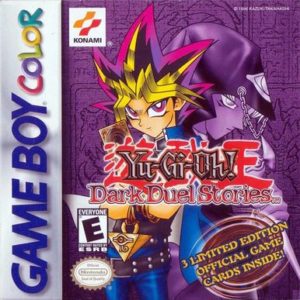 The first set of game promos I’ll talk about are the ones from Dark Duel Stories, a Gameboy Color game from March 19th, 2002. The promos printed in this game were Blue-Eyes White Dragon, Dark Magician, Exodia the Forbidden One, Seiyaryu, Acid Trap Hole, and Salamandra. Now as previously mentioned, I won’t go over the first three promos since they were previously released in another product, therefore we’ll only talk about Seiyaryu, Acid Trap Hole, and Salamandra. Seiyaryu is a Level 7 LIGHT Dragon with 2500 ATK and 2300 DEF and it has no effect, so as you might expect, this wasn’t really a competitive card, therefore demand wasn’t going to be high outside collectors markets, meaning the reprint wasn’t going to be necessary. Therefore its first reprint was inside Turbo Pack: Booster Seven, released on January 1st, 2012. Now it wasn’t a real mass reprint since players don’t really get to access Turbo Packs without earning them from tournaments or buying them from whoever earned them off an online shop, but the card was lucky enough to get another reprint in Legendary Collection 4: Joey’s World on October 11, 2013. Acid Trap Hole is the next promo, which is a Normal Trap that flips a face-down monster face-up to check and see if it has 2000 or less DEF and then destroys the monster if it does and returns it face-down if it doesn’t. A solid card, but I don’t remember it being a big meta staple. This, however; was the quickest of the three promos first released with this game to get a reprint, as it was first reprinted in the Shadow of Infinity: Special Edition on April 1st, 2006. Salamandra is the last card from this game, and is an Equip Spell that boosts a FIRE monster by 700 ATK. Another card that isn’t really a meta staple, even in FIRE decks, so a reprint wasn’t as necessary, and it didn’t get one until Duelist League 15 on December 15th, 2012 and as Duelist League isn’t something most players come by, it should be noted it got the first mass reprint in Legendary Collection 4 as well on October 11th, 2013.
The first set of game promos I’ll talk about are the ones from Dark Duel Stories, a Gameboy Color game from March 19th, 2002. The promos printed in this game were Blue-Eyes White Dragon, Dark Magician, Exodia the Forbidden One, Seiyaryu, Acid Trap Hole, and Salamandra. Now as previously mentioned, I won’t go over the first three promos since they were previously released in another product, therefore we’ll only talk about Seiyaryu, Acid Trap Hole, and Salamandra. Seiyaryu is a Level 7 LIGHT Dragon with 2500 ATK and 2300 DEF and it has no effect, so as you might expect, this wasn’t really a competitive card, therefore demand wasn’t going to be high outside collectors markets, meaning the reprint wasn’t going to be necessary. Therefore its first reprint was inside Turbo Pack: Booster Seven, released on January 1st, 2012. Now it wasn’t a real mass reprint since players don’t really get to access Turbo Packs without earning them from tournaments or buying them from whoever earned them off an online shop, but the card was lucky enough to get another reprint in Legendary Collection 4: Joey’s World on October 11, 2013. Acid Trap Hole is the next promo, which is a Normal Trap that flips a face-down monster face-up to check and see if it has 2000 or less DEF and then destroys the monster if it does and returns it face-down if it doesn’t. A solid card, but I don’t remember it being a big meta staple. This, however; was the quickest of the three promos first released with this game to get a reprint, as it was first reprinted in the Shadow of Infinity: Special Edition on April 1st, 2006. Salamandra is the last card from this game, and is an Equip Spell that boosts a FIRE monster by 700 ATK. Another card that isn’t really a meta staple, even in FIRE decks, so a reprint wasn’t as necessary, and it didn’t get one until Duelist League 15 on December 15th, 2012 and as Duelist League isn’t something most players come by, it should be noted it got the first mass reprint in Legendary Collection 4 as well on October 11th, 2013.
Seiyaryu: 9 Years, 9 Months, and 13 Days between video game printing and first non-mass reprint and 11 Years, 6 Months, and 22 Days between video game printing and first mass reprint.
Acid Trap Hole: 4 Years and 13 Days between video game printing and first mass reprint.
Salamandra: 10 Years, 8 Months, and 26 Days between video game printing and first non-mass reprint and 11 Years, 6 Months, and 22 Days between video game printing and first mass reprint.
Yu-Gi-Oh The Eternal Duelist Soul
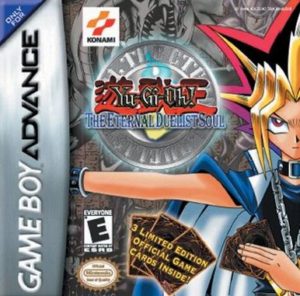 The next game is the Gameboy Advance’s Eternal Duelist Soul, released on October 15th, 2002. The three video game promos that came with this game were Exchange, Graceful Dice, and Skull Dice. Exchange is a Normal Spell that lets players choose and swap cards in their hands and wasn’t really a meta powerhouse, meaning a reprint wasn’t as necessary, but it only had to wait til the release of Dark Beginning 1 on October 12th, 2004. Graceful Dice was a Quick-Play Spell that rolled a dice and boosted your monsters ATK/DEF by the result x100, so it wasn’t that good of a card, so it wasn’t in high demand besides being an anime card that Joey used. It had to wait all the way until the release of Gold Series 4: Pyramids Edition on June 24th, 2011 for its first reprint. Skull Dice is a card similar to Graceful Dice, only it’s a Normal Trap and it debuffs the opponent’s monsters by the dice result x100. Like Graceful Dice, Skull Dice wasn’t as good and a reprint wasn’t as needed, so it also waited until Gold Series 4 for its first reprint.
The next game is the Gameboy Advance’s Eternal Duelist Soul, released on October 15th, 2002. The three video game promos that came with this game were Exchange, Graceful Dice, and Skull Dice. Exchange is a Normal Spell that lets players choose and swap cards in their hands and wasn’t really a meta powerhouse, meaning a reprint wasn’t as necessary, but it only had to wait til the release of Dark Beginning 1 on October 12th, 2004. Graceful Dice was a Quick-Play Spell that rolled a dice and boosted your monsters ATK/DEF by the result x100, so it wasn’t that good of a card, so it wasn’t in high demand besides being an anime card that Joey used. It had to wait all the way until the release of Gold Series 4: Pyramids Edition on June 24th, 2011 for its first reprint. Skull Dice is a card similar to Graceful Dice, only it’s a Normal Trap and it debuffs the opponent’s monsters by the dice result x100. Like Graceful Dice, Skull Dice wasn’t as good and a reprint wasn’t as needed, so it also waited until Gold Series 4 for its first reprint.
Exchange: 1 Year, 11 Months, and 27 Days between video game printing and first mass reprint.
Graceful Dice and Skull Dice: 8 Years, 8 Months, and 9 Days between video game printings and first mass reprints.
Yu-Gi-Oh Forbidden Memories
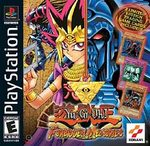 The next game is Forbidden Memories, released on the PlayStation on November 25th, 2002. The first promo for this game is Harpie’s Pet Dragon, which is a Level 7 WIND Dragon with 2000 ATK, 2500 DEF, and gains 300 ATK/DEF for each Harpie Lady on the field. Not a real powerhouse, but it was needed for Harpie’s when they got support in 2013. Thankfully it got a reprint in Retro Pack 2 on July 28th, 2009 first, though it didn’t really help much when the Harpie support came. Red-Eyes Black Metal Dragon and Metalmorph are next, where Metalmorph is a Normal Trap that equips to a monster, gives it 300 ATK while equipped and half the ATK of a monster it attacks during damage calculation, while Red-Eyes Black Metal Dragon is a Level 8 DARK Machine with 2800 ATK, 2400 DEF, cannot be Normal Summoned/Set and must be Special Summoned from the deck by tributing a Red-Eyes Black Dragon equipped with the aforementioned Metalmorph. Overall, mostly anime cards that satisfy collectors, especially Red-Eyes Black Metal Dragon. Both had to wait until the release of the first Premium Pack on October 8th, 2007 for a reprint.
The next game is Forbidden Memories, released on the PlayStation on November 25th, 2002. The first promo for this game is Harpie’s Pet Dragon, which is a Level 7 WIND Dragon with 2000 ATK, 2500 DEF, and gains 300 ATK/DEF for each Harpie Lady on the field. Not a real powerhouse, but it was needed for Harpie’s when they got support in 2013. Thankfully it got a reprint in Retro Pack 2 on July 28th, 2009 first, though it didn’t really help much when the Harpie support came. Red-Eyes Black Metal Dragon and Metalmorph are next, where Metalmorph is a Normal Trap that equips to a monster, gives it 300 ATK while equipped and half the ATK of a monster it attacks during damage calculation, while Red-Eyes Black Metal Dragon is a Level 8 DARK Machine with 2800 ATK, 2400 DEF, cannot be Normal Summoned/Set and must be Special Summoned from the deck by tributing a Red-Eyes Black Dragon equipped with the aforementioned Metalmorph. Overall, mostly anime cards that satisfy collectors, especially Red-Eyes Black Metal Dragon. Both had to wait until the release of the first Premium Pack on October 8th, 2007 for a reprint.
Harpie’s Pet Dragon: 6 Years, 8 Months, and 3 Days between video game printing and first mass reprint.
Metalmorph and Red-Eyes Black Metal Dragon: 4 Years, 10 Months, and 13 Days between video game printings and first mass reprints.
Yu-Gi-Oh! The Duelists of the Roses
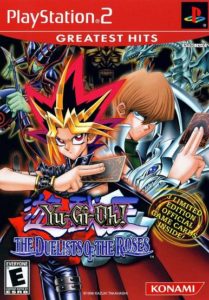 The next game is one from the PS2, The Duelists of the Roses, which was released on February 16th, 2003 and came with the three Magnet Warriors: Alpha, Beta, and Gamma. I’m sure most to all of us know they’re Level 4 EARTH Rocks with no effects and with stats of 1400/1700 for Alpha, 1700/1600 for Beta, and 1500/1800 for Gamma. They all usually come together, so fitting they all have their first reprints together in Retro Pack 2 on July 28th, 2009. I highly doubted that they would of just reprinted one or two of the Magnet Warriors and not reprint the third, so thankfully if you waited for these reprints, you likely knew you’ll get them all at once.
The next game is one from the PS2, The Duelists of the Roses, which was released on February 16th, 2003 and came with the three Magnet Warriors: Alpha, Beta, and Gamma. I’m sure most to all of us know they’re Level 4 EARTH Rocks with no effects and with stats of 1400/1700 for Alpha, 1700/1600 for Beta, and 1500/1800 for Gamma. They all usually come together, so fitting they all have their first reprints together in Retro Pack 2 on July 28th, 2009. I highly doubted that they would of just reprinted one or two of the Magnet Warriors and not reprint the third, so thankfully if you waited for these reprints, you likely knew you’ll get them all at once.
Alpha, Beta, and Gamma the Magnet Warriors: 6 Years, 5 Months, and 12 Days between video game printings and first mass reprints.
Yu-Gi-Oh! Worldwide Edition: Stairway to the Destined Duel
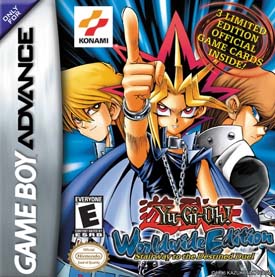 Back to a Gameboy Advance game, this time being Stairway to the Destined Duel, which was released on April 15th, 2003. The promos in this game were Valkyrion the Magna Warrior, Sinister Serpent, and Harpie’s Feather Duster. Valkyrion the Magna Warrior is a Level 8 EARTH Rock with 3500/3850 stats and must be summoned by tributing the previously mentioned three Magnet Warriors and can tribute itself to resummon the three Magnet Warriors. Not a competitive card, but Konami has seemed to reprint this alongside the Magnet Warriors ever since all of them were legal, so it’s first reprint was in Retro Pack 2 alongside the Magnet Warriors on July 28th, 2009. The next card is the legendary Sinister Serpent, a Level 1 WATER Reptile with 300/250 stats and if it is in the graveyard during the Standby Phase, it returns to the hand (at least that’s what it did pre-errata). It was a very powerful card back in the day and one that got banned long before it got its first reprint in Legendary Collection 3 on September 29th, 2012. The last card is another famous one, the Normal Spell known as Harpie’s Feather Duster that destroyed all your opponent’s Spells and Traps. Another easily ban worthy card, and one that got banned before the first reprint. Though this one got a reprint in Tournament Pack 8 first on April 28th, 2006 and then waited until Battle Pack: Epic Dawn on May 24th, 2012 for its first mass reprint.
Back to a Gameboy Advance game, this time being Stairway to the Destined Duel, which was released on April 15th, 2003. The promos in this game were Valkyrion the Magna Warrior, Sinister Serpent, and Harpie’s Feather Duster. Valkyrion the Magna Warrior is a Level 8 EARTH Rock with 3500/3850 stats and must be summoned by tributing the previously mentioned three Magnet Warriors and can tribute itself to resummon the three Magnet Warriors. Not a competitive card, but Konami has seemed to reprint this alongside the Magnet Warriors ever since all of them were legal, so it’s first reprint was in Retro Pack 2 alongside the Magnet Warriors on July 28th, 2009. The next card is the legendary Sinister Serpent, a Level 1 WATER Reptile with 300/250 stats and if it is in the graveyard during the Standby Phase, it returns to the hand (at least that’s what it did pre-errata). It was a very powerful card back in the day and one that got banned long before it got its first reprint in Legendary Collection 3 on September 29th, 2012. The last card is another famous one, the Normal Spell known as Harpie’s Feather Duster that destroyed all your opponent’s Spells and Traps. Another easily ban worthy card, and one that got banned before the first reprint. Though this one got a reprint in Tournament Pack 8 first on April 28th, 2006 and then waited until Battle Pack: Epic Dawn on May 24th, 2012 for its first mass reprint.
Valkyrion the Magna Warrior: 6 Years, 3 Months, and 13 Days between video game printing and first mass reprint.
Sinister Serpent: 9 Years, 5 Months, and 14 Days between video game printing and first mass reprint.
Harpie’s Feather Duster: 3 Years and 13 Days between video game printing and first non-mass reprint and 9 Years, 1 Month, and 9 Days between video game printing and first mass reprint.
Yu-Gi-Oh! The Sacred Cards
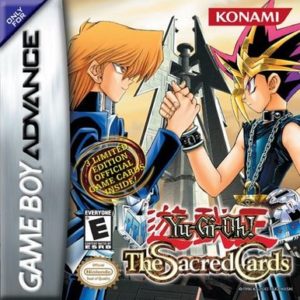 Yet another Gameboy Advance game, The Sacred Cards, which was released on November 4th 2013 and featured Perfectly Ultimate Great Moth, Riryoku, and Negate Attack as promos. Perfectly Ultimate Great Moth as many know is a Level 8 EARTH Insect with 3500/3000 stats and must be summoned by tributing a Petit Moth equipped with Cocoon of Evolution for 6 exact turns. Hard to summon card, but an iconic anime card nonetheless, and one that waited until Dark Beginning 2 on July 27th, 2005 for a reprint. The next card is the Normal Spell known as Riryoku that halves the ATK of an opponent’s monster and gives said ATK to your monster for a turn. A pretty underwhelming Spell when compared to Harpie’s Feather Duster, this got its first reprint in Shadow of Infinity: Special Edition on April 1st, 2006. The third promo is the Negate Attack Counter Trap, which just negates an opponent’s attack and ends the Battle Phase. A pretty simple card and since Jaden ended up using it in the GX anime, it got a reprint in Duelist Pack: Jaden Yuki on February 8th, 2006.
Yet another Gameboy Advance game, The Sacred Cards, which was released on November 4th 2013 and featured Perfectly Ultimate Great Moth, Riryoku, and Negate Attack as promos. Perfectly Ultimate Great Moth as many know is a Level 8 EARTH Insect with 3500/3000 stats and must be summoned by tributing a Petit Moth equipped with Cocoon of Evolution for 6 exact turns. Hard to summon card, but an iconic anime card nonetheless, and one that waited until Dark Beginning 2 on July 27th, 2005 for a reprint. The next card is the Normal Spell known as Riryoku that halves the ATK of an opponent’s monster and gives said ATK to your monster for a turn. A pretty underwhelming Spell when compared to Harpie’s Feather Duster, this got its first reprint in Shadow of Infinity: Special Edition on April 1st, 2006. The third promo is the Negate Attack Counter Trap, which just negates an opponent’s attack and ends the Battle Phase. A pretty simple card and since Jaden ended up using it in the GX anime, it got a reprint in Duelist Pack: Jaden Yuki on February 8th, 2006.
Perfectly Ultimate Great Moth: 1 Year, 8 Months, and 23 Days between video game printing and first mass reprint.
Riryoku: 2 Years, 4 Months, and 28 Days between video game printing and first mass reprint.
Negate Attack: 2 Years, 3 Months, and 4 Days between video game printing and first mass reprint.
Yu-Gi-Oh! The Falsebound Kingdom
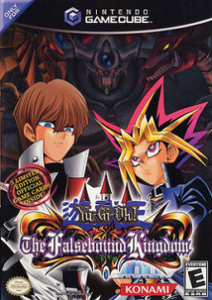 In a strange twist, we have another game released on November 4th, 2003 but this time it is a game for the Nintendo Gamecube and it’s known as The Falsebound Kingdom. The promos for this game were Zoa, Metalzoa, and Goblin Fan. Zoa is a Level 7 DARK Fiend with 2600/1900 stats and no effect while Metalzoa is a Level 8 DARK Machine with 3000/2300 stats and must be summoned from the deck by tributing a Zoa equipped with Metalmorph. These two easily go hand-and-hand, so it made sense for both to get their first reprint in the World Championship 2011 pack on August 1st, 2011 and their first mass reprints each in Legendary Collection 4: Joey’s World on October 11th, 2013. Goblin Fan is a Continuous Trap that destroys a Level 2 or lower monster upon it being Flip Summoned and prevents its effects from activating at that time. This card also got its first reprint in the World Championship 2011 pack, but its first mass reprint came 1 year earlier than the previous cards, as Goblin Fan was in Legendary Collection 3: Yugi’s World on September 29th, 2012.
In a strange twist, we have another game released on November 4th, 2003 but this time it is a game for the Nintendo Gamecube and it’s known as The Falsebound Kingdom. The promos for this game were Zoa, Metalzoa, and Goblin Fan. Zoa is a Level 7 DARK Fiend with 2600/1900 stats and no effect while Metalzoa is a Level 8 DARK Machine with 3000/2300 stats and must be summoned from the deck by tributing a Zoa equipped with Metalmorph. These two easily go hand-and-hand, so it made sense for both to get their first reprint in the World Championship 2011 pack on August 1st, 2011 and their first mass reprints each in Legendary Collection 4: Joey’s World on October 11th, 2013. Goblin Fan is a Continuous Trap that destroys a Level 2 or lower monster upon it being Flip Summoned and prevents its effects from activating at that time. This card also got its first reprint in the World Championship 2011 pack, but its first mass reprint came 1 year earlier than the previous cards, as Goblin Fan was in Legendary Collection 3: Yugi’s World on September 29th, 2012.
Zoa and Metalzoa: 7 Years, 8 Months, and 29 Days between video game printings and first non-mass reprints and 9 Years, 11 Months, and 7 Days between video game printings and first mass reprints.
Goblin Fan: 7 Years, 8 Months, and 29 Days between video game printing and first non-mass reprint and 8 Years, 10 Months, and 25 Days between video game printing and first mass reprint.
Yu-Gi-Oh! Power of Chaos: Yugi the Destiny
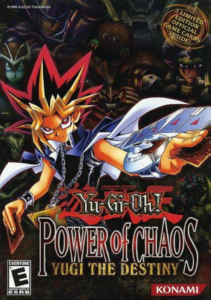 It’s time to discuss the promos from the first of three Power of Chaos games on the PC, starting with Yugi the Destiny from November 18th, 2003. The promos that came with this PC game were Windstorm of Etaqua, Anti-Spell Fragrance, Thousand Knives, Dark Magician, and Kuriboh. I’ll only talk about the first three since Dark Magician and Kuriboh were reprints. Windstorm of Etaqua is a Normal Trap that changes the battle positions of all face up monsters the opponent controls. A pretty disruptive Trap for the Battle Phase, it received its first reprint in Shadow of Infinity: Special Edition on April 1st, 2006. Next is Anti-Spell Fragrance, a Continuous Trap that makes players set Spells before using them and makes them wait a turn to do so. A card that is extremely good against Spell strategies, it gained popularity as Pendulums came out. It’s first reprint was in Champion Pack: Game Five on January 8th, 2008 and it received reprints in Turbo Pack: Booster Two, Duel Terminal 4, and OTS Tournament Pack 1 before finally getting its first mass reprint in Battles of Legend: Light’s Revenge on July 6th, 2017. Finally, Thousand Knives is the Normal Spell that targets and destroys an opponent’s monster if you control Dark Magician, a card that obviously got better with more Dark Magician cards. Like Anti-Spell Fragrance, it also got its first reprint in Champion Pack: Game Five though didn’t wait as long for the mass reprint as that came in Legendary Collection 3: Yugi’s World on September 29th, 2012.
It’s time to discuss the promos from the first of three Power of Chaos games on the PC, starting with Yugi the Destiny from November 18th, 2003. The promos that came with this PC game were Windstorm of Etaqua, Anti-Spell Fragrance, Thousand Knives, Dark Magician, and Kuriboh. I’ll only talk about the first three since Dark Magician and Kuriboh were reprints. Windstorm of Etaqua is a Normal Trap that changes the battle positions of all face up monsters the opponent controls. A pretty disruptive Trap for the Battle Phase, it received its first reprint in Shadow of Infinity: Special Edition on April 1st, 2006. Next is Anti-Spell Fragrance, a Continuous Trap that makes players set Spells before using them and makes them wait a turn to do so. A card that is extremely good against Spell strategies, it gained popularity as Pendulums came out. It’s first reprint was in Champion Pack: Game Five on January 8th, 2008 and it received reprints in Turbo Pack: Booster Two, Duel Terminal 4, and OTS Tournament Pack 1 before finally getting its first mass reprint in Battles of Legend: Light’s Revenge on July 6th, 2017. Finally, Thousand Knives is the Normal Spell that targets and destroys an opponent’s monster if you control Dark Magician, a card that obviously got better with more Dark Magician cards. Like Anti-Spell Fragrance, it also got its first reprint in Champion Pack: Game Five though didn’t wait as long for the mass reprint as that came in Legendary Collection 3: Yugi’s World on September 29th, 2012.
Windstorm of Etaqua: 2 Years, 4 Months, and 14 Days between video game printing and first mass reprint.
Anti-Spell Fragrance: 4 Years, 1 Month, and 21 Days between video game printing and first non-mass reprint and 13 Years, 7 Months, and 18 Days between video game printing and first non-mass reprint.
Thousand Knives: 4 Years, 1 Month, and 21 Days between video game printing and first non-mass reprint and 8 Years, 10 Months, and 11 Days between video game printing and first mass reprint.
Yu-Gi-Oh! World Championship Tournament 2004
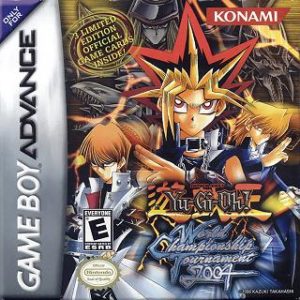 The first of the World Championship series of games was on the Gameboy Advance and was released on February 10, 2004. The promos for this game were Fairy King Truesdale, Kinetic Soldier (known today as Cipher Soldier), and Slate Warrior. Fairy King Truesdale is a Level 6 WATER Plant with 2200/1500 stats and that boosts all your Plants by 500 ATK and DEF while in Defense Position. Not a great card, got its first reprint in Champion Pack: Game Seven on September 1st, 2008 and hasn’t been reprinted since. The next card is Kinetic Soldier (AKA Cipher Soldier) which is a Level 3 EARTH Machine with 1350/1800 stats and gains 2000 ATK and DEF when battling a Warrior monster. Very good in earlier formats that had Warrior based metas, its first reprint came in Champion Pack: Game four on September 6th, 2007 and got its first mass reprint in the Machina Mayhem Structure Deck on February 19th, 2010. Finally you got Slate Warrior, a monster with 1900/400 stats, a FLIP effect that gives it another 500 ATK and DEF and it debuffs whatever destroys it in battle by 500 ATK and DEF. A Kaiba card if I remember correctly, its first reprint came in Tournament Pack 8 on April 28th, 2006 before getting another reprint months later in Structure Deck: Lord of the Storm on July 12th, 2006.
The first of the World Championship series of games was on the Gameboy Advance and was released on February 10, 2004. The promos for this game were Fairy King Truesdale, Kinetic Soldier (known today as Cipher Soldier), and Slate Warrior. Fairy King Truesdale is a Level 6 WATER Plant with 2200/1500 stats and that boosts all your Plants by 500 ATK and DEF while in Defense Position. Not a great card, got its first reprint in Champion Pack: Game Seven on September 1st, 2008 and hasn’t been reprinted since. The next card is Kinetic Soldier (AKA Cipher Soldier) which is a Level 3 EARTH Machine with 1350/1800 stats and gains 2000 ATK and DEF when battling a Warrior monster. Very good in earlier formats that had Warrior based metas, its first reprint came in Champion Pack: Game four on September 6th, 2007 and got its first mass reprint in the Machina Mayhem Structure Deck on February 19th, 2010. Finally you got Slate Warrior, a monster with 1900/400 stats, a FLIP effect that gives it another 500 ATK and DEF and it debuffs whatever destroys it in battle by 500 ATK and DEF. A Kaiba card if I remember correctly, its first reprint came in Tournament Pack 8 on April 28th, 2006 before getting another reprint months later in Structure Deck: Lord of the Storm on July 12th, 2006.
Fairy King Truesdale: 4 Years, 6 Months, and 22 Days between video game printing and first non-mass reprint and hasn’t been mass reprinted.
Kinetic/Cipher Soldier: 3 Years, 6 Months, and 27 Days between video game printing and first non-mass reprint and 6 Years and 9 Days between video game printing and first mass reprint.
Slate Warrior: 2 Years, 2 Months, and 18 Days between video game printing and first non-mass reprint and 2 Years, 5 Months, and 2 Days between video game printing and first mass reprint.
Yu-Gi-Oh! The Dawn of Destiny
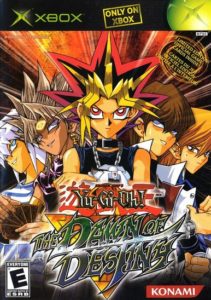 Now we get to an Xbox game in The Dawn of Destiny on March 23, 2004 and came with The Winged Dragon of Ra, Dark Sage, and Widespread Ruin. Now, since The Winged Dragon of Ra wasn’t playable at this time, I won’t discuss it (plus it was printed beforehand in another game). Dark Sage is a Level 9 DARK Spellcaster with 2800/3200 stats and can only be summoned by tributing a Dark Magician after you flipped the coin for the effect of Time Wizard and got it right, plus upon being summoned this way searches for any Spell in your deck. An iconic anime card, this only waited until Dark Beginning 1 on October 12, 2004 before getting a reprint. The other card is Widespread Ruin, a Normal Trap that destroyed your opponent’s strongest monster when they declared an attack. Arguably better or worse than Sakuretsu Armor, this got its first reprint in Champion Pack: Game Three on May 15th, 2005 and then being in the Yu-Gi-Oh 5D’s 2009 Starter Deck on June 9th, 2009 for its first mass reprint.
Now we get to an Xbox game in The Dawn of Destiny on March 23, 2004 and came with The Winged Dragon of Ra, Dark Sage, and Widespread Ruin. Now, since The Winged Dragon of Ra wasn’t playable at this time, I won’t discuss it (plus it was printed beforehand in another game). Dark Sage is a Level 9 DARK Spellcaster with 2800/3200 stats and can only be summoned by tributing a Dark Magician after you flipped the coin for the effect of Time Wizard and got it right, plus upon being summoned this way searches for any Spell in your deck. An iconic anime card, this only waited until Dark Beginning 1 on October 12, 2004 before getting a reprint. The other card is Widespread Ruin, a Normal Trap that destroyed your opponent’s strongest monster when they declared an attack. Arguably better or worse than Sakuretsu Armor, this got its first reprint in Champion Pack: Game Three on May 15th, 2005 and then being in the Yu-Gi-Oh 5D’s 2009 Starter Deck on June 9th, 2009 for its first mass reprint.
Dark Sage: 6 Months and 19 Days between video game printing and first mass reprint.
Widespread Ruin: 3 Years, 1 Month, and 22 Days between video game printing and first non-mass reprint and 5 Years, 2 Months, and 17 Days between video game printing and first mass reprint.
Yu-Gi-Oh! Power of Chaos: Kaiba the Revenge
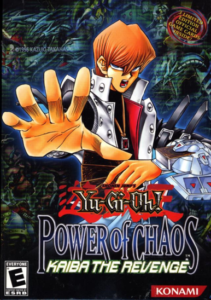 The second installment of the Power of Chaos series on the PC has Kaiba the Revenge on April 6, 2004. This game came with Blue-Eyes White Dragon, Aqua Chorus, and Seal of the Ancients. Blue-Eyes has been printed before this and many times since this, so no need to discuss it here. Aqua Chorus is a Continuous Trap that boosts all monsters on the field by 500 ATK and DEF if there’s a monster on the field with the same name. Not a good card, it’s only reprint came in Structure Deck: Lord of the Storm on July 12, 2006. The other card is Seal of the Ancients, a Normal Spell that pays 1000 of your LP to let you look at your opponent’s set cards and then put them back to being set. Another card that hasn’t seen much play, this has never been reprinted at all, whether in a Tournament Pack or a reprint set. Now I can see that changing someday in some sort of Speed Duel set very soon, but for now this is the only way you can get Seal of the Ancients.
The second installment of the Power of Chaos series on the PC has Kaiba the Revenge on April 6, 2004. This game came with Blue-Eyes White Dragon, Aqua Chorus, and Seal of the Ancients. Blue-Eyes has been printed before this and many times since this, so no need to discuss it here. Aqua Chorus is a Continuous Trap that boosts all monsters on the field by 500 ATK and DEF if there’s a monster on the field with the same name. Not a good card, it’s only reprint came in Structure Deck: Lord of the Storm on July 12, 2006. The other card is Seal of the Ancients, a Normal Spell that pays 1000 of your LP to let you look at your opponent’s set cards and then put them back to being set. Another card that hasn’t seen much play, this has never been reprinted at all, whether in a Tournament Pack or a reprint set. Now I can see that changing someday in some sort of Speed Duel set very soon, but for now this is the only way you can get Seal of the Ancients.
Aqua Chorus: 2 Years, 3 Months, and 5 Days between video game printing and first mass reprint.
Seal of the Ancients: Never reprinted.
Yu-Gi-Oh! Reshef of Destruction
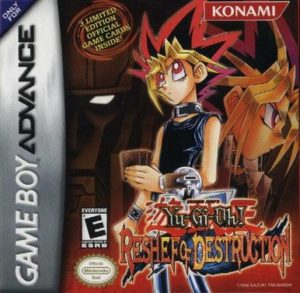 Another Gameboy Advance game, Reshef of Destruction was released on June 29th, 2004 and came with Dark Magician Knight, Knight’s Title, and Sage’s Stone. Dark Magician Knight must be summoned with Knight’s Title (a Normal Spell that tributes a Dark Magician to summon Dark Magician Knight from the hand, deck, or graveyard) and targets a card on the field and destroys it upon being Special Summoned. Mostly iconic anime cards, these got their first reprint in a Double Pack that came with Reshef of Destruction as well as The Sacred Cards on February 22th, 2006 before getting mass reprints in Legendary Collection 3 on September 29th, 2012. Sage’s Stone is another Normal Spell that summons a Dark Magician from the hand or deck if you control a face-up Dark Magician Girl. Another iconic anime card, this one got its first reprint in Gold Series 4: Pyramids Edition on June 24, 2011.
Another Gameboy Advance game, Reshef of Destruction was released on June 29th, 2004 and came with Dark Magician Knight, Knight’s Title, and Sage’s Stone. Dark Magician Knight must be summoned with Knight’s Title (a Normal Spell that tributes a Dark Magician to summon Dark Magician Knight from the hand, deck, or graveyard) and targets a card on the field and destroys it upon being Special Summoned. Mostly iconic anime cards, these got their first reprint in a Double Pack that came with Reshef of Destruction as well as The Sacred Cards on February 22th, 2006 before getting mass reprints in Legendary Collection 3 on September 29th, 2012. Sage’s Stone is another Normal Spell that summons a Dark Magician from the hand or deck if you control a face-up Dark Magician Girl. Another iconic anime card, this one got its first reprint in Gold Series 4: Pyramids Edition on June 24, 2011.
Dark Magician Knight and Knight’s Title: 1 Year, 7 Months, and 24 Days between two video game promo printings and 8 Years and 3 Months between video game printings and first mass reprints.
Sage’s Stone: 6 Years, 11 Months, and 26 Days between video game printing and first mass reprint.
Yu-Gi-Oh! Power of Chaos: Joey the Passion
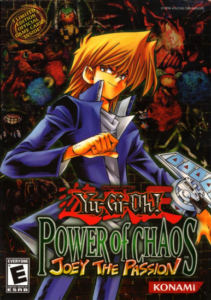 Now the final installment of the Power of Chaos games on the PC, we have Joey the Passion on June 29th, 2004. The promos for this game were Red-Eyes B. Dragon, Sebek’s Blessing, and Sword of Dragon’s Soul. Red-Eyes B. Dragon has had tons of reprints before and after this game’s release. Sebek’s Blessing is a Quick-Play Spell that lets you gain LP equal to the amount of damage you just dealt the opponent via a direct attack. It received its first reprint in the Dinosaur’s Rage Structure Deck on October 20th, 2006. The other card is Sword of Dragon’s Soul, an Equip Spell that equips only to a Warrior, gives it 700 ATK, and if the equipped monster battled a Dragon after Damage Calculation, said Dragon is destroyed during the end of the Battle Phase. This card waited all the way until the Speed Duel: Arena of Lost Souls set on March 28th, 2019 for its first reprint.
Now the final installment of the Power of Chaos games on the PC, we have Joey the Passion on June 29th, 2004. The promos for this game were Red-Eyes B. Dragon, Sebek’s Blessing, and Sword of Dragon’s Soul. Red-Eyes B. Dragon has had tons of reprints before and after this game’s release. Sebek’s Blessing is a Quick-Play Spell that lets you gain LP equal to the amount of damage you just dealt the opponent via a direct attack. It received its first reprint in the Dinosaur’s Rage Structure Deck on October 20th, 2006. The other card is Sword of Dragon’s Soul, an Equip Spell that equips only to a Warrior, gives it 700 ATK, and if the equipped monster battled a Dragon after Damage Calculation, said Dragon is destroyed during the end of the Battle Phase. This card waited all the way until the Speed Duel: Arena of Lost Souls set on March 28th, 2019 for its first reprint.
Sebek’s Blessing: 2 Years, 3 Months, and 21 Days between video game printing and first mass reprint.
Sword of Dragon’s Soul: 14 Years, 8 Months, and 27 Days between video game printing and first mass reprint.
Yu-Gi-Oh! Destiny Board Traveler
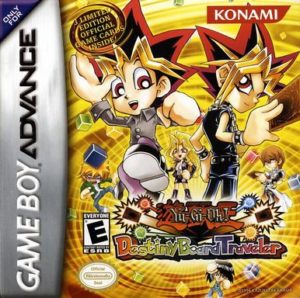 More Gameboy Advance games, now we get to Destiny Board Traveler, which was released on October 26th, 2004 and came with Emes the Infinity, D.D. Assailant, and Twinheaded Beast. Emes the Infinity is a Level 7 LIGHT Machine with 2500/2000 stats and gains 700 ATK each time it destroys a monster in battle and sends it to the graveyard. A card that isn’t too iconic or that great, it has never been reprinted outside of this game. The next promo is D.D. Assailant, a Level 4 EARTH Warrior with 1700/1600 stats and banished any monster that destroyed it in battle alongside himself. It was a pretty good replacement for D.D. Warrior Lady, who I believe was limited at the time, it got its first reprint in Champion Pack: Game Three on May 15th, 2005 and later got its first mass reprint in Dark Revelation Volume 4 (very rare product now, but it was in stores so I’ll count it) on November 14th, 2007. Finally you got Twinheaded Beast, a Level 6 FIRE Beast-Warrior with 1700/1900 stats and the ability to attack twice. A lackluster card that has not seen a reprint alongside Emes the Infinity. If it wasn’t for D.D. Assailant, this game would have exclusivity for its promos, though there are other games with promos only released with said game.
More Gameboy Advance games, now we get to Destiny Board Traveler, which was released on October 26th, 2004 and came with Emes the Infinity, D.D. Assailant, and Twinheaded Beast. Emes the Infinity is a Level 7 LIGHT Machine with 2500/2000 stats and gains 700 ATK each time it destroys a monster in battle and sends it to the graveyard. A card that isn’t too iconic or that great, it has never been reprinted outside of this game. The next promo is D.D. Assailant, a Level 4 EARTH Warrior with 1700/1600 stats and banished any monster that destroyed it in battle alongside himself. It was a pretty good replacement for D.D. Warrior Lady, who I believe was limited at the time, it got its first reprint in Champion Pack: Game Three on May 15th, 2005 and later got its first mass reprint in Dark Revelation Volume 4 (very rare product now, but it was in stores so I’ll count it) on November 14th, 2007. Finally you got Twinheaded Beast, a Level 6 FIRE Beast-Warrior with 1700/1900 stats and the ability to attack twice. A lackluster card that has not seen a reprint alongside Emes the Infinity. If it wasn’t for D.D. Assailant, this game would have exclusivity for its promos, though there are other games with promos only released with said game.
Emes the Infinity and Twinheaded Beast: Never reprinted.
D.D. Assailant: 2 Years, 6 Months, and 19 Days between video game printing and first non-mass reprint and 3 Years and 19 Days between video game printing and first mass reprint.
Yu-Gi-Oh! Capsule Monster Coliseum
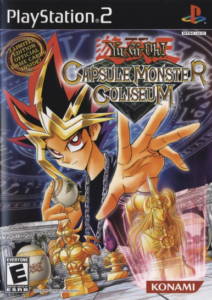 Another game for the PS2, Capsule Monster Coliseum was released on November 26th, 2004 and came with Abyss Soldier, Inferno Hammer, and Teva. Abyss Soldier is a Level 4 WATER Aqua with 1800/1300 stats and lets you discard a WATER monster once per turn to target a card on the field and return it to the hand. Good in very early WATER strategies and I believe was on the F/L list at some point, it was first reprinted in Champion Pack: Game Two on February 6th, 2007 and after a reprint in Duel Terminal 6b, it got its first mass reprint in the Realm of the Sea Emperor Structure Deck on October 11th, 2012. Inferno Hammer is a Level 6 DARK Fiend with 2400/0 stats and will flip a face-up monster the opponent controls face-down when this guy destroys a monster in battle and sends it to the graveyard. It’s a card that hasn’t been reprinted alongside the other promo in this game. Teva is a Level 5 LIGHT Warrior with 2000/1500 stats and prevents the opponent from attacking on their next turn when it is Tribute Summoned successfully. It’s a card I honestly had no clue existed until I saw a random Duel Links deck using and abusing its effect, I guess it never being reprinted helped make it more obscure.
Another game for the PS2, Capsule Monster Coliseum was released on November 26th, 2004 and came with Abyss Soldier, Inferno Hammer, and Teva. Abyss Soldier is a Level 4 WATER Aqua with 1800/1300 stats and lets you discard a WATER monster once per turn to target a card on the field and return it to the hand. Good in very early WATER strategies and I believe was on the F/L list at some point, it was first reprinted in Champion Pack: Game Two on February 6th, 2007 and after a reprint in Duel Terminal 6b, it got its first mass reprint in the Realm of the Sea Emperor Structure Deck on October 11th, 2012. Inferno Hammer is a Level 6 DARK Fiend with 2400/0 stats and will flip a face-up monster the opponent controls face-down when this guy destroys a monster in battle and sends it to the graveyard. It’s a card that hasn’t been reprinted alongside the other promo in this game. Teva is a Level 5 LIGHT Warrior with 2000/1500 stats and prevents the opponent from attacking on their next turn when it is Tribute Summoned successfully. It’s a card I honestly had no clue existed until I saw a random Duel Links deck using and abusing its effect, I guess it never being reprinted helped make it more obscure.
Inferno Hammer and Teva: Never reprinted.
Abyss Soldier: 2 Years, 2 Months, and 11 Days between video game printing and first non-mass reprint and 7 Years, 10 Months, and 15 Days between video game printing and first mass reprint.
Yu-Gi-Oh! 7 Trials to Glory: World Championship Tournament 2005
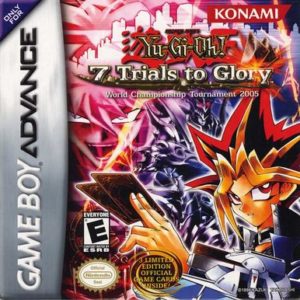 The next series of the World Championship series of games came on the Gameboy Advance on February 15, 2005 and gave us Silent Swordsman LV7, Kaibaman, and Mind Control as promos. Silent Swordsman LV7 is a Level 7 LIGHT Warrior with 2800/1000 stats, can only be summoned via the effect of Silent Swordsman LV5, and negates the effects of all Spells on the field. A card I’m sure we recognize since Yugi used Silent Swordsman in the anime, the card waited until Duel Terminal 6a on February 3rd, 2012 for its first reprint and for Legendary Collection 3 on September 29th, 2012 for its first mass reprint. Next up is Kaibaman, a Level 3 LIGHT Warrior with 200/700 stats and can be tributed to summon Blue-Eyes White Dragon from the hand. Another iconic card, though this time mostly through Yu-Gi-Oh GX and how the card is very similar to Kaiba himself, this card waited until Champion Pack: Game Three on May 15th, 2007 for its first reprint and for Dark Revelation Volume 4 on November 14th, 2007 for its first mass reprint. Finally you got Mind Control, the Normal Spell that steals an opponent’s monster for the turn, but prevents you from attacking with it or using it for a Tribute Summon. This one has seen on and off play over the years, and unlike the other two promos, this one’s first reprint was a mass reprint in Gold Series 2009 on April 21st, 2009.
The next series of the World Championship series of games came on the Gameboy Advance on February 15, 2005 and gave us Silent Swordsman LV7, Kaibaman, and Mind Control as promos. Silent Swordsman LV7 is a Level 7 LIGHT Warrior with 2800/1000 stats, can only be summoned via the effect of Silent Swordsman LV5, and negates the effects of all Spells on the field. A card I’m sure we recognize since Yugi used Silent Swordsman in the anime, the card waited until Duel Terminal 6a on February 3rd, 2012 for its first reprint and for Legendary Collection 3 on September 29th, 2012 for its first mass reprint. Next up is Kaibaman, a Level 3 LIGHT Warrior with 200/700 stats and can be tributed to summon Blue-Eyes White Dragon from the hand. Another iconic card, though this time mostly through Yu-Gi-Oh GX and how the card is very similar to Kaiba himself, this card waited until Champion Pack: Game Three on May 15th, 2007 for its first reprint and for Dark Revelation Volume 4 on November 14th, 2007 for its first mass reprint. Finally you got Mind Control, the Normal Spell that steals an opponent’s monster for the turn, but prevents you from attacking with it or using it for a Tribute Summon. This one has seen on and off play over the years, and unlike the other two promos, this one’s first reprint was a mass reprint in Gold Series 2009 on April 21st, 2009.
Silent Swordsman LV7: 6 Years, 11 Months, and 19 Days between video game printing and first non-mass reprint and 7 Years, 7 Months, and 14 Days between video game printing and first mass reprint.
Kaibaman: 2 Years and 3 Months between video game printing and first non-mass reprint and 2 Years, 8 Months, and 30 Days between video game printing and first mass reprint.
Mind Control: 4 Years, 2 Months, and 6 Days between video game printing and first mass reprint.
Yu-Gi-Oh! Nightmare Troubadour
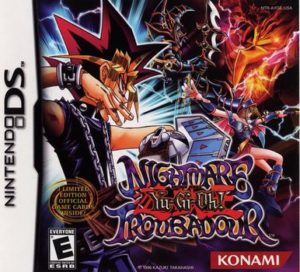 We finally move to the Nintendo DS era with Nightmare Troubadour. This game came with Silent Magician LV4, Silent Magician LV8, and Magician’s Circle. Silent Magician LV4 is a Level 4 LIGHT Spellcaster with 1000/1000 stats, gains a Spell Counter (max. 5) when the opponent draws, gains 500 ATK per Spell Counter, and during the next Standby Phase after the 5th counter was placed it’ll go to the graveyard to summon Silent Magician LV8 from the hand or deck. Similar to Silent Swordsman in terms of how iconic it is from the anime, this card was first reprinted in Champion Pack: Game Eight on January 5th, 2009 before getting its first mass reprint in Legendary Collection 3 on September 29th, 2012. Silent Magician LV8 is a Level 8 LIGHT Spellcaster with 3500/1000 stats, can only be summoned off of Silent Magician LV4, and is unaffected by Spells. This card didn’t get the reprint in Champion Pack: Game Eight alongside its LV4 counterpart, but it was with it in Legendary Collection 3. Finally we get to Magician’s Circle, a Normal Trap that lets each player summon a Spellcaster with 2000 or less ATK from their deck if they can when a Spellcaster declares an attack. A good card for earlier Spellcaster decks, the card got its first reprint in Champion Pack: Game Four on September 6th, 2007 before getting its first mass reprint in the Spellcaster’s Command Structure Deck on March 31st, 2009.
We finally move to the Nintendo DS era with Nightmare Troubadour. This game came with Silent Magician LV4, Silent Magician LV8, and Magician’s Circle. Silent Magician LV4 is a Level 4 LIGHT Spellcaster with 1000/1000 stats, gains a Spell Counter (max. 5) when the opponent draws, gains 500 ATK per Spell Counter, and during the next Standby Phase after the 5th counter was placed it’ll go to the graveyard to summon Silent Magician LV8 from the hand or deck. Similar to Silent Swordsman in terms of how iconic it is from the anime, this card was first reprinted in Champion Pack: Game Eight on January 5th, 2009 before getting its first mass reprint in Legendary Collection 3 on September 29th, 2012. Silent Magician LV8 is a Level 8 LIGHT Spellcaster with 3500/1000 stats, can only be summoned off of Silent Magician LV4, and is unaffected by Spells. This card didn’t get the reprint in Champion Pack: Game Eight alongside its LV4 counterpart, but it was with it in Legendary Collection 3. Finally we get to Magician’s Circle, a Normal Trap that lets each player summon a Spellcaster with 2000 or less ATK from their deck if they can when a Spellcaster declares an attack. A good card for earlier Spellcaster decks, the card got its first reprint in Champion Pack: Game Four on September 6th, 2007 before getting its first mass reprint in the Spellcaster’s Command Structure Deck on March 31st, 2009.
Silent Magician LV4: 3 Years, 4 Months, and 6 Days between video game printing and first non-mass reprint and 7 Years and 30 Days between video game printing and first mass reprint.
Silent Magician LV8: 7 Years and 30 Days between video game printing and first mass reprint.
Magician’s Circle: 2 Years and 7 Days between video game printing and first non-mass reprint and 3 Years, 7 Months, and 1 Day between video game printing and first mass reprint.
Yu-Gi-Oh! GX Duel Academy
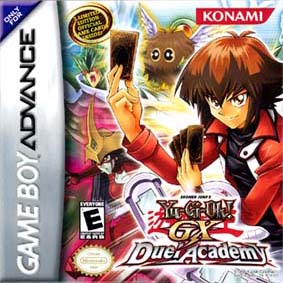 Another Gameboy Advance game, only this time moving into the GX generation of the series with Duel Academy on January 10th, 2006. The promos in this game were Elemental HERO Necroshade, Winged Kuriboh, and Hero Ring. Winged Kuriboh was previously in The Lost Millennium, so no need to discuss it here. Elemental HERO Necroshade is a Level 5 DARK Warrior with 1600/1800 stats and lets you Normal Summon an Elemental HERO once without tributes while it is in the graveyard. A piece of one of the most beloved archetypes ever, it was first reprinted in Starter Deck: Jaden Yuki on July 25th, 2007. The other card is Hero Ring, a Normal Trap that equips to a monster with 1500 or less ATK and prevents monsters with 1900 or more ATK from attacking it. One of Jaden’s cards in the anime, this card received its first reprint in Legendary Collection 2 on October 4th, 2011.
Another Gameboy Advance game, only this time moving into the GX generation of the series with Duel Academy on January 10th, 2006. The promos in this game were Elemental HERO Necroshade, Winged Kuriboh, and Hero Ring. Winged Kuriboh was previously in The Lost Millennium, so no need to discuss it here. Elemental HERO Necroshade is a Level 5 DARK Warrior with 1600/1800 stats and lets you Normal Summon an Elemental HERO once without tributes while it is in the graveyard. A piece of one of the most beloved archetypes ever, it was first reprinted in Starter Deck: Jaden Yuki on July 25th, 2007. The other card is Hero Ring, a Normal Trap that equips to a monster with 1500 or less ATK and prevents monsters with 1900 or more ATK from attacking it. One of Jaden’s cards in the anime, this card received its first reprint in Legendary Collection 2 on October 4th, 2011.
Elemental HERO Necroshade: 1 Year, 6 Months, and 15 Days between video game printing and first mass reprint.
Hero Ring: 5 Years, 8 Months, and 24 Days between video game printing and first mass reprint.
Yu-Gi-Oh! Ultimate Masters: World Championship Tournament 2006
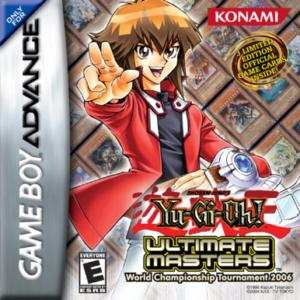 Though the series is still on the Gameboy Advance, the World Championship series has entered the GX era on March 14th, 2006 and gave us Golden Homunculus, Helios – The Primordial Sun, and Helios Duo Megistus for promos. Golden Homunculus is a Level 6 LIGHT Warrior with 1500/1500 stats and it gains 300 ATK and DEF for each of your banished cards. A pretty decent card in banish strategies, the card was first reprinted in The Dark Emperor Structure Deck on April 2nd, 2008. Helios – The Primordial Sun is a Level 4 LIGHT Pyro whose stats are equal to your banished monsters times 100. The reason you can use Solemn Warning on Macro Cosmo, this card was also reprinted in The Dark Emperor Structure Deck alongside Golden Homunculus. Helios Duo Megistus is a Level 6 LIGHT Pyro that can be Special Summoned by tributing the first Helios, gains 200 ATK and DEF per banished monster, and it can revive itself at the end of the turn it was destroyed in battle and sent to the graveyard and it gets another 300 ATK/DEF boost. Shockingly, this card’s only reprint was in Champion Pack: Game Six on May 12th, 2008 and hasn’t been printed since.
Though the series is still on the Gameboy Advance, the World Championship series has entered the GX era on March 14th, 2006 and gave us Golden Homunculus, Helios – The Primordial Sun, and Helios Duo Megistus for promos. Golden Homunculus is a Level 6 LIGHT Warrior with 1500/1500 stats and it gains 300 ATK and DEF for each of your banished cards. A pretty decent card in banish strategies, the card was first reprinted in The Dark Emperor Structure Deck on April 2nd, 2008. Helios – The Primordial Sun is a Level 4 LIGHT Pyro whose stats are equal to your banished monsters times 100. The reason you can use Solemn Warning on Macro Cosmo, this card was also reprinted in The Dark Emperor Structure Deck alongside Golden Homunculus. Helios Duo Megistus is a Level 6 LIGHT Pyro that can be Special Summoned by tributing the first Helios, gains 200 ATK and DEF per banished monster, and it can revive itself at the end of the turn it was destroyed in battle and sent to the graveyard and it gets another 300 ATK/DEF boost. Shockingly, this card’s only reprint was in Champion Pack: Game Six on May 12th, 2008 and hasn’t been printed since.
Golden Homunculus and Helios – The Primordial Sun: 2 Years and 19 Days between video game printings and first mass reprints.
Helios Duo Megistus: 2 Years, 1 Month, and 28 Days between video game printing and first non-mass reprint.
Yu-Gi-Oh! GX Tag Force
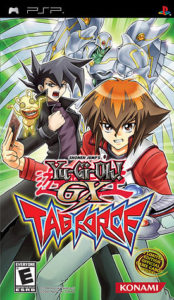 Now we finally get to the first PSP game and of course it’s the first of the well-known Tag Force series, which was released on November 16th, 2006. The promos that came with this were Phantom Beast Cross-Wing, Phantom Beast Wild-Horn, and Phantom Beast Thunder-Pegasus. Cross-Wing is a Level 4 LIGHT Beast-Warrior with 1300/1300 stats and gives your Phantom Beast monsters another 300 ATK while it is in the graveyard. Wild-Horn is a Level 4 EARTH Beast-Warrior with 1700/0 stats and does piercing damage. Finally, Thunder-Pegasus is a Level 4 LIGHT Beast-Warrior with 700/2000 stats and can banish itself from the graveyard when a Gazelle the King of Mythical Beasts or a Phantom Beast monster is being attacked to bring the damage to 0 and protect your monster from being destroyed in that battle. Basically being the whole archetype minus a card, these were all reprinted together in Gold Series 2009 on April 21st, 2009 with the fourth card in the archetype that was previously in the Force of the Breaker: Special Edition.
Now we finally get to the first PSP game and of course it’s the first of the well-known Tag Force series, which was released on November 16th, 2006. The promos that came with this were Phantom Beast Cross-Wing, Phantom Beast Wild-Horn, and Phantom Beast Thunder-Pegasus. Cross-Wing is a Level 4 LIGHT Beast-Warrior with 1300/1300 stats and gives your Phantom Beast monsters another 300 ATK while it is in the graveyard. Wild-Horn is a Level 4 EARTH Beast-Warrior with 1700/0 stats and does piercing damage. Finally, Thunder-Pegasus is a Level 4 LIGHT Beast-Warrior with 700/2000 stats and can banish itself from the graveyard when a Gazelle the King of Mythical Beasts or a Phantom Beast monster is being attacked to bring the damage to 0 and protect your monster from being destroyed in that battle. Basically being the whole archetype minus a card, these were all reprinted together in Gold Series 2009 on April 21st, 2009 with the fourth card in the archetype that was previously in the Force of the Breaker: Special Edition.
Phantom Beast Cross-Wing, Phantom Beast Wild-Horn, and Phantom Beast Thunder-Pegasus: 2 Years, 5 Months, and 5 Days between video game printings and first mass reprints.
Yu-Gi-Oh! GX Spirit Caller
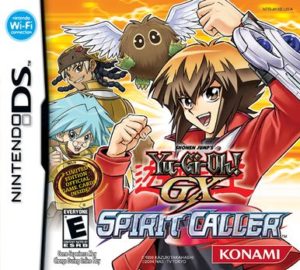 We return to the Nintendo DS for the Spirit Caller game released on January 2nd, 2007. This game gave us Brain Crusher, Hunter Owl, and Masked Chopper for video game promos. Brain Crusher is a Level 7 DARK Insect with 2400/1500 stats and at the end of the Battle Phase it can revive a monster it destroyed in battle and sent to the graveyard that turn. Though Goyo Guardian was the first to make this effect good, this card did fit the theme of Battle Pack 2: War of the Giants, therefore it was reprinted in that set on June 28th, 2013. Hunter Owl is a Level 4 WIND Winged-Beast with 1000/500 stats, gains 500 ATK for each WIND you control, and cannot be attacked while you control another WIND. An obvious generic WIND support card, this card was first reprinted in a WIND based Structure Deck in Dragunity Legion on March 4th, 2011. Masked Chopper is a Level 1 EARTH Fiend with 100/100 stats and deals 2000 effect damage when it destroys a monster by battle. A card that would of been far better on any monster with better stats, this card has never received a reprint ever, which I guess is fine since it’s one of the worst cards ever and wasn’t really prevalent in the anime.
We return to the Nintendo DS for the Spirit Caller game released on January 2nd, 2007. This game gave us Brain Crusher, Hunter Owl, and Masked Chopper for video game promos. Brain Crusher is a Level 7 DARK Insect with 2400/1500 stats and at the end of the Battle Phase it can revive a monster it destroyed in battle and sent to the graveyard that turn. Though Goyo Guardian was the first to make this effect good, this card did fit the theme of Battle Pack 2: War of the Giants, therefore it was reprinted in that set on June 28th, 2013. Hunter Owl is a Level 4 WIND Winged-Beast with 1000/500 stats, gains 500 ATK for each WIND you control, and cannot be attacked while you control another WIND. An obvious generic WIND support card, this card was first reprinted in a WIND based Structure Deck in Dragunity Legion on March 4th, 2011. Masked Chopper is a Level 1 EARTH Fiend with 100/100 stats and deals 2000 effect damage when it destroys a monster by battle. A card that would of been far better on any monster with better stats, this card has never received a reprint ever, which I guess is fine since it’s one of the worst cards ever and wasn’t really prevalent in the anime.
Brain Crusher: 6 Years, 5 Months, and 26 Days between video game printing and first mass reprint.
Hunter Owl: 4 Years, 2 Months, and 2 Days between video game printing and first mass reprint.
Masked Chopper: Never reprinted.
Yu-Gi-Oh! World Championship 2007
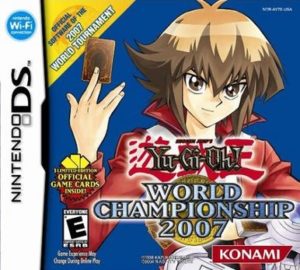 After a few installments, the World Championship series finally entered the Nintendo DS era on March 20th, 2007 and gave us Spell Striker, Exploder Dragon, and Destiny HERO – Disk Commander. Spell Striker was a Level 3 EARTH Warrior with 600/200 stats, could be Special Summoned from the hand by banishing a Spell in your graveyard, you didn’t take damage from battles involving it, and it could attack directly. A pretty good card to get on the field easily, this card was first reprinted in Champion Pack: Game Seven on September 1st, 2008 before getting its first mass reprint in the Warriors’ Strike Structure Deck on October 23rd, 2009. Exploder Dragon is a Level 3 EARTH Dragon with 1000/0 stats, prevents both players from taking battle damage from battles involving it when it attacked, and it destroyed any monster that destroyed it in battle. Another pretty decent card, this got its first reprint in Gold Series 3 on June 18th, 2010. Finally, we got Destiny HERO – Disk Commander, which didn’t have the errata back then of course and originally let you draw 2 cards every time you Special Summoned it from the grave. A card so powerful that it was banned, its first reprint was long after the banning of it in Legendary Collection 2 on October 4th, 2011.
After a few installments, the World Championship series finally entered the Nintendo DS era on March 20th, 2007 and gave us Spell Striker, Exploder Dragon, and Destiny HERO – Disk Commander. Spell Striker was a Level 3 EARTH Warrior with 600/200 stats, could be Special Summoned from the hand by banishing a Spell in your graveyard, you didn’t take damage from battles involving it, and it could attack directly. A pretty good card to get on the field easily, this card was first reprinted in Champion Pack: Game Seven on September 1st, 2008 before getting its first mass reprint in the Warriors’ Strike Structure Deck on October 23rd, 2009. Exploder Dragon is a Level 3 EARTH Dragon with 1000/0 stats, prevents both players from taking battle damage from battles involving it when it attacked, and it destroyed any monster that destroyed it in battle. Another pretty decent card, this got its first reprint in Gold Series 3 on June 18th, 2010. Finally, we got Destiny HERO – Disk Commander, which didn’t have the errata back then of course and originally let you draw 2 cards every time you Special Summoned it from the grave. A card so powerful that it was banned, its first reprint was long after the banning of it in Legendary Collection 2 on October 4th, 2011.
Spell Striker: 1 Year, 5 Months, and 12 Days between video game printing and first non-mass reprint and 2 Years, 7 Months, and 7 Days between video game printing and first mass reprint.
Exploder Dragon: 3 Years, 2 Months, and 29 Days between video game printing and first mass reprint.
Destiny HERO – Disk Commander: 4 Years, 6 Months, and 14 Days between video game printing and first mass reprint.
Yu-Gi-Oh! GX Tag Force 2
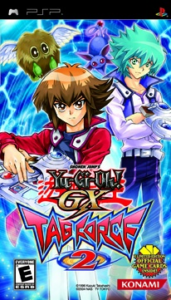 Next up for the PSP we got the second installment of the Tag Force series that was released on September 18th, 2007 and gave us Mad Reloader, Dark Bribe, and Chaos Burst for promos. Mad Reloader is a Level 1 DARK Fiend with 0/0 stats and upon being destroyed by battle let you send two cards from the hand to the graveyard to draw 2 cards. It’s a pretty ok card, it’s first reprint came in Battle Pack: Epic Dawn on May 24th, 2012. Dark Bribe is a Counter Trap that negated the activation of an opponent’s Spell/Trap, destroyed it, and then let them draw a card. A very good Counter Trap back in the day and still ok to this day, its first reprint came in the Warriors’ Strike Structure Deck on October 23rd, 2009. Chaos Burst is a Normal Trap that when the opponent declared an attack, you could tribute a monster to destroy the attacking monster and burn the opponent for 1000 damage. There were many cards that did what this card did, but better. It’s first reprint came in Battle Pack 3: Monster League on July 31st, 2014.
Next up for the PSP we got the second installment of the Tag Force series that was released on September 18th, 2007 and gave us Mad Reloader, Dark Bribe, and Chaos Burst for promos. Mad Reloader is a Level 1 DARK Fiend with 0/0 stats and upon being destroyed by battle let you send two cards from the hand to the graveyard to draw 2 cards. It’s a pretty ok card, it’s first reprint came in Battle Pack: Epic Dawn on May 24th, 2012. Dark Bribe is a Counter Trap that negated the activation of an opponent’s Spell/Trap, destroyed it, and then let them draw a card. A very good Counter Trap back in the day and still ok to this day, its first reprint came in the Warriors’ Strike Structure Deck on October 23rd, 2009. Chaos Burst is a Normal Trap that when the opponent declared an attack, you could tribute a monster to destroy the attacking monster and burn the opponent for 1000 damage. There were many cards that did what this card did, but better. It’s first reprint came in Battle Pack 3: Monster League on July 31st, 2014.
Mad Reloader: 4 Years, 8 Months, and 6 Days between video game printing and first mass reprint.
Dark Bribe: 1 Year, 2 Months, and 3 Days between video game printing and first mass reprint.
Chaos Burst: 6 Years, 10 Months, and 13 Days between video game printing and first mass reprint.
Yu-Gi-Oh! World Championship 2008
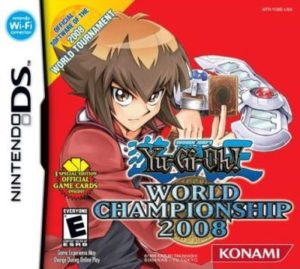 Strangely, the World Championship 2008 game on the DS was released on December 4th, 2007. The game gave us Deep Diver, Burden of the Mighty, and Dimensional Prison for video game promos. Deep Diver is a Level 3 WATER Aqua with 1000/1100 stats and at the end of the Battle Phase it was destroyed by battle and sent to the graveyard, you could take a monster from your deck and place it on top of your deck. The card is kinda mediocre and it’s first reprint came in Battle Pack: Epic Dawn on May 24th, 2012. Burden of the Mighty is a Continuous Spell that makes every monster your opponent controls lose 100 ATK times their Level. A card that got worse over the years, its first reprint came in the Warriors’ Strike Structure Deck on October 23rd, 2009 when it didn’t have to worry about monsters not having Levels yet. Dimensional Prison is a Normal Trap that targeting an attacking monster from the opponent and banished it. A great card back in the prime of Battle Traps, this cards first reprint came in the Machina Mayhem Structure Deck on February 19th, 2010.
Strangely, the World Championship 2008 game on the DS was released on December 4th, 2007. The game gave us Deep Diver, Burden of the Mighty, and Dimensional Prison for video game promos. Deep Diver is a Level 3 WATER Aqua with 1000/1100 stats and at the end of the Battle Phase it was destroyed by battle and sent to the graveyard, you could take a monster from your deck and place it on top of your deck. The card is kinda mediocre and it’s first reprint came in Battle Pack: Epic Dawn on May 24th, 2012. Burden of the Mighty is a Continuous Spell that makes every monster your opponent controls lose 100 ATK times their Level. A card that got worse over the years, its first reprint came in the Warriors’ Strike Structure Deck on October 23rd, 2009 when it didn’t have to worry about monsters not having Levels yet. Dimensional Prison is a Normal Trap that targeting an attacking monster from the opponent and banished it. A great card back in the prime of Battle Traps, this cards first reprint came in the Machina Mayhem Structure Deck on February 19th, 2010.
Deep Diver: 4 Years, 5 Months, and 20 Days between video game printing and first mass reprint.
Burden of the Mighty: 1 Year, 10 Months, and 19 Days between video game printing and first mass reprint.
Dimensional Prison: 2 Years, 2 Months, and 15 Days between video game printing and first mass reprint.
Yu-Gi-Oh! GX Tag Force Evolution
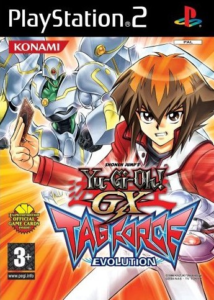 On the PS2 instead of the PSP we have Tag Force Evolution released on December 7th, 2007 and it gave us Nurse Reficule the Fallen One (known today as Darklord Nurse Reficule), Dark Cure, and Brutal Potion. The former Nurse Reficule the Fallen One is a Level 4 DARK Fairy with 1400/600 stats and turns any life points the opponent would of gained into burn. A staple in the Nurse Burn strategy, when the localization of this card became a problem with the release of the Darklord archetype, a reprint was necessary to change its name, so it got one and the name changed officially to Darklord Nurse Reficule in Destiny Soldiers on November 17th, 2016. Dark Cure is a Continuous Trap that let the opponent gain LP equal to half the ATK of a monster they summoned, you’d choose if they summoned multiple at once. In theory, it was meant for Nurse Burn, but there were better cards for that, so this never received a reprint as it wasn’t really necessary. Brutal Potion is a Normal Trap that becomes an Equip Card, equips to a monster you control, and lets the monster gain 1000 ATK each time you inflict effect damage to the opponent. A very lackluster card, this has yet to receive a reprint as well as it isn’t necessary either.
On the PS2 instead of the PSP we have Tag Force Evolution released on December 7th, 2007 and it gave us Nurse Reficule the Fallen One (known today as Darklord Nurse Reficule), Dark Cure, and Brutal Potion. The former Nurse Reficule the Fallen One is a Level 4 DARK Fairy with 1400/600 stats and turns any life points the opponent would of gained into burn. A staple in the Nurse Burn strategy, when the localization of this card became a problem with the release of the Darklord archetype, a reprint was necessary to change its name, so it got one and the name changed officially to Darklord Nurse Reficule in Destiny Soldiers on November 17th, 2016. Dark Cure is a Continuous Trap that let the opponent gain LP equal to half the ATK of a monster they summoned, you’d choose if they summoned multiple at once. In theory, it was meant for Nurse Burn, but there were better cards for that, so this never received a reprint as it wasn’t really necessary. Brutal Potion is a Normal Trap that becomes an Equip Card, equips to a monster you control, and lets the monster gain 1000 ATK each time you inflict effect damage to the opponent. A very lackluster card, this has yet to receive a reprint as well as it isn’t necessary either.
Nurse Reficule the Fallen One (AKA Darklord Nurse Reficule): 8 Years, 11 Months, and 10 Days between video game printing and first mass reprint.
Dark Cure and Brutal Potion: Never reprinted.
Yu-Gi-Oh! GX Tag Force 3
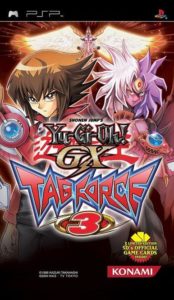 Tag Force 3 is an odd one since on November 28th, 2008 the game was printed in the English language, but only in Europe and never in the Americas. The cards in this game were Gallis the Star Beast, Red-Eyes Wyvern, and Darkness Destroyer. Gallis the Star Beast is a Level 3 EARTH Beast with 800/800 stats and it let you reveal this card in your hand to then reveal the top card of your deck and send it to the graveyard, if it was a monster you excavated it and Special Summoned this from the hand while burning the opponent for the excavated monster’s Level times 200, and if the card was a Spell/Trap then you would discard Gallis and take 500 damage. The card has seen usage over the years and its first reprint, and first printing outside Europe, came on October 4th, 2011 in Legendary Collection 2. Red-Eyes Wyvern is a Level 4 WIND Dragon with 1800/1600 stats and it could banish itself from the graveyard at the end of a turn you didn’t Normal Summon/Set to revive any Red-Eyes monster. A good card back in the day to revive Red-Eyes Darkness Metal Dragon, this card got its first reprint in the Ancient Prophecy: Special Edition on October 9th, 2009. Finally we got Darkness Destroyer, a Level 7 DARK Fiend with 2300/1800 stats, cannot be Special Summoned, can attack twice, and do piercing damage. Mostly being iconic from the GX Season 4 that was never dubbed, this card was reprinted in Legendary Collection 2 for its first mass reprint just like Gallis the Star Beast.
Tag Force 3 is an odd one since on November 28th, 2008 the game was printed in the English language, but only in Europe and never in the Americas. The cards in this game were Gallis the Star Beast, Red-Eyes Wyvern, and Darkness Destroyer. Gallis the Star Beast is a Level 3 EARTH Beast with 800/800 stats and it let you reveal this card in your hand to then reveal the top card of your deck and send it to the graveyard, if it was a monster you excavated it and Special Summoned this from the hand while burning the opponent for the excavated monster’s Level times 200, and if the card was a Spell/Trap then you would discard Gallis and take 500 damage. The card has seen usage over the years and its first reprint, and first printing outside Europe, came on October 4th, 2011 in Legendary Collection 2. Red-Eyes Wyvern is a Level 4 WIND Dragon with 1800/1600 stats and it could banish itself from the graveyard at the end of a turn you didn’t Normal Summon/Set to revive any Red-Eyes monster. A good card back in the day to revive Red-Eyes Darkness Metal Dragon, this card got its first reprint in the Ancient Prophecy: Special Edition on October 9th, 2009. Finally we got Darkness Destroyer, a Level 7 DARK Fiend with 2300/1800 stats, cannot be Special Summoned, can attack twice, and do piercing damage. Mostly being iconic from the GX Season 4 that was never dubbed, this card was reprinted in Legendary Collection 2 for its first mass reprint just like Gallis the Star Beast.
Gallis the Star Beast and Darkness Destroyer: 2 Years, 10 Months, and 6 Days between video game printings and first mass reprints.
Red-Eyes Wyvern: 10 Months and 11 Days between video game printing and first mass reprint.
Yu-Gi-Oh! 5D’s World Championship 2009: Stardust Accelerator
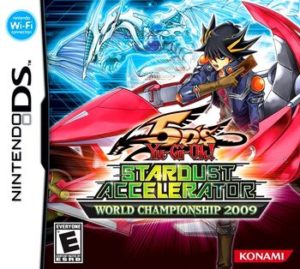 We enter the 5D’s era of video games for World Championship 2009: Stardust Accelerator, which was released on May 19th, 2009. For the promos, we got Infernity Archfiend, Infernity Dwarf, and Infernity Guardian. Infernity Archfiend is a Level 4 DARK Fiend with 1800/1200 stats, can Special Summon itself from the hand if you draw it while you have no other cards in your hand, and searches for an Infernity cards when Special Summoned if you have no cards in your hand when you activate and resolve this effect. Infernity Dwarf is a Level 2 DARK Warrior with 800/600 stats and gives all your monsters piercing while you have no cards in your hand. Infernity Guardian is a Level 4 DARK Fiend with 1200/1700 stats and cannot be destroyed by battle or by card effects while you have no cards in your hand. Infernity Archfiend is one of the most important cards for the Infernity archetype while Dwarf and Guardian are two cards you could pass on. These cards were all reprinted in Gold Series 3 on June 18th, 2010 around the time The Shining Darkness gave us new Infernity support that made them meta.
We enter the 5D’s era of video games for World Championship 2009: Stardust Accelerator, which was released on May 19th, 2009. For the promos, we got Infernity Archfiend, Infernity Dwarf, and Infernity Guardian. Infernity Archfiend is a Level 4 DARK Fiend with 1800/1200 stats, can Special Summon itself from the hand if you draw it while you have no other cards in your hand, and searches for an Infernity cards when Special Summoned if you have no cards in your hand when you activate and resolve this effect. Infernity Dwarf is a Level 2 DARK Warrior with 800/600 stats and gives all your monsters piercing while you have no cards in your hand. Infernity Guardian is a Level 4 DARK Fiend with 1200/1700 stats and cannot be destroyed by battle or by card effects while you have no cards in your hand. Infernity Archfiend is one of the most important cards for the Infernity archetype while Dwarf and Guardian are two cards you could pass on. These cards were all reprinted in Gold Series 3 on June 18th, 2010 around the time The Shining Darkness gave us new Infernity support that made them meta.
Infernity Archfiend, Infernity Dwarf, and Infernity Guardian: 1 Year and 30 Days between video game printings and first mass reprints.
Yu-Gi-Oh! 5D’s Wheelie Breakers
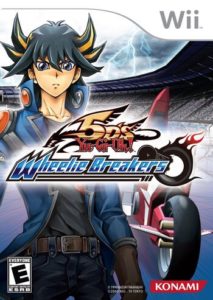 Wheelie Breakers is one of the few rare Wii games in the Yu-Gi-Oh franchise. Released on May 19th, 2009, this game gave us Supersonic Skull Flame, Skull Flame, and Burning Skull Head for promos. Supersonic Skull Flame is a Level 10 WIND Zombie with 2600/2000 stats, can only be Special Summoned by banishing 1 Skull Flame from your graveyard, burns the opponent for 400 damage for each Burning Skull Head in your graveyard, and revives a Skull Flame from the graveyard when it it sent from the field to the graveyard. Skull Flame is a Level 8 FIRE Zombie with 2600/2000 stats, can Special Summon a Burning Skull Head from your hand once per turn while preventing you from entering the Battle Phase the turn you use said effect, and you can add a Burning Skull Head from your graveyard to you hand during your Draw Phase instead of conducting your normal draw. Burning Skull Head is a Level 3 FIRE Zombie with 1000/800 stats, burns the opponent for 1000 damage when Special Summoned from the hand, and can banish itself face-up from the field to return a banished Skull Flame to your graveyard. These cards were mostly known from Hunter Pace using them in the 5D’s anime in a few episodes and they never had a real impact. They have never been reprinted since this game was originally printed.
Wheelie Breakers is one of the few rare Wii games in the Yu-Gi-Oh franchise. Released on May 19th, 2009, this game gave us Supersonic Skull Flame, Skull Flame, and Burning Skull Head for promos. Supersonic Skull Flame is a Level 10 WIND Zombie with 2600/2000 stats, can only be Special Summoned by banishing 1 Skull Flame from your graveyard, burns the opponent for 400 damage for each Burning Skull Head in your graveyard, and revives a Skull Flame from the graveyard when it it sent from the field to the graveyard. Skull Flame is a Level 8 FIRE Zombie with 2600/2000 stats, can Special Summon a Burning Skull Head from your hand once per turn while preventing you from entering the Battle Phase the turn you use said effect, and you can add a Burning Skull Head from your graveyard to you hand during your Draw Phase instead of conducting your normal draw. Burning Skull Head is a Level 3 FIRE Zombie with 1000/800 stats, burns the opponent for 1000 damage when Special Summoned from the hand, and can banish itself face-up from the field to return a banished Skull Flame to your graveyard. These cards were mostly known from Hunter Pace using them in the 5D’s anime in a few episodes and they never had a real impact. They have never been reprinted since this game was originally printed.
Supersonic Skull Flame, Skull Flame, and Burning Skull Head: Never reprinted.
Yu-Gi-Oh! 5D’s Tag Force 4
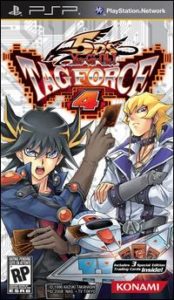 The Tag Force series is once again released worldwide on the PSP with the first installment of the 5D’s series on November 17th, 2009. This game came with Warm Worm, Worm Bait, and Regretful Rebirth as promos. Warm Worm is a Level 3 FIRE Insect with 600/1400 stats and makes your opponent send the top three cards of their deck to the graveyard when destroyed. This card is mostly good in Duel Links rather than the TCG game, so it hasn’t been reprinted yet, but I can see it being printed in a Speed Duel pack someday at least. Worm Bait is a Normal Spell that lets you summon 2 Worm Tokens that are Level 1 EARTH Insects with 0/0 stats, but you cannot summon Level 3 or 4 monsters the turn you activate this effect. A card that got better with Links entering the game, this card was first reprinted in Legendary Duelists: Ancient Millennium on February 22nd, 2018. Regretful Rebirth is a Normal Trap that revives a monster in face-up Defense Position that is destroyed by battle and sent to your graveyard, but destroys it during your next End Phase. A pretty mediocre revival card, though at a time a lot of them were either not printed or on the F/L list, this card’s first reprint came in the Onslaught of the Fire Kings Structure Deck on February 8th, 2013.
The Tag Force series is once again released worldwide on the PSP with the first installment of the 5D’s series on November 17th, 2009. This game came with Warm Worm, Worm Bait, and Regretful Rebirth as promos. Warm Worm is a Level 3 FIRE Insect with 600/1400 stats and makes your opponent send the top three cards of their deck to the graveyard when destroyed. This card is mostly good in Duel Links rather than the TCG game, so it hasn’t been reprinted yet, but I can see it being printed in a Speed Duel pack someday at least. Worm Bait is a Normal Spell that lets you summon 2 Worm Tokens that are Level 1 EARTH Insects with 0/0 stats, but you cannot summon Level 3 or 4 monsters the turn you activate this effect. A card that got better with Links entering the game, this card was first reprinted in Legendary Duelists: Ancient Millennium on February 22nd, 2018. Regretful Rebirth is a Normal Trap that revives a monster in face-up Defense Position that is destroyed by battle and sent to your graveyard, but destroys it during your next End Phase. A pretty mediocre revival card, though at a time a lot of them were either not printed or on the F/L list, this card’s first reprint came in the Onslaught of the Fire Kings Structure Deck on February 8th, 2013.
Warm Worm: Never reprinted.
Worm Bait: 8 Years, 3 Months, and 5 Days between video game printing and first mass reprint.
Regretful Rebirth: 3 Years, 2 Months, and 22 Days between video game printing and first mass reprint.
Yu-Gi-Oh! 5D’s World Championship 2010: Reverse of Arcadia
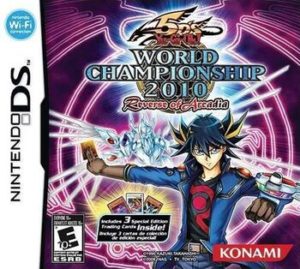 The second to last installment of the World Championship series on the DS was released on February 23rd, 2010 and gave us Samurai Sword Baron, Stygian Security, and Stygian Sergeants for promos. Samurai Sword Baron is a Level 4 EARTH Warrior with 1600/1200 stats and once per turn can change a Defense Position monster your opponent controls to Attack Position. A pretty lackluster card for 2010, this card has never been reprinted outside this game’s release. Stygian Security is a Level 1 DARK Fiend Tuner with 100/600 stats and Special Summons a Level 1 Fiend from your deck if destroyed by battle. A pretty decent floater, this card’s first reprint came in the Pendulum Domination Structure Deck on January 19th, 2017. Stygian Sergeants is a Level 5 DARK Fiend Synchro of any Fiend Tuner and any non-Tuners, has 2200/1800 stats, and if it destroys a monster by battle and sends it to the graveyard, it can gain 800 ATK and make a second attack in a row. A decent Synchro for Fiends to utilize, this card’s first reprint came in Legendary Collection 5D’s on October 23rd, 2014.
The second to last installment of the World Championship series on the DS was released on February 23rd, 2010 and gave us Samurai Sword Baron, Stygian Security, and Stygian Sergeants for promos. Samurai Sword Baron is a Level 4 EARTH Warrior with 1600/1200 stats and once per turn can change a Defense Position monster your opponent controls to Attack Position. A pretty lackluster card for 2010, this card has never been reprinted outside this game’s release. Stygian Security is a Level 1 DARK Fiend Tuner with 100/600 stats and Special Summons a Level 1 Fiend from your deck if destroyed by battle. A pretty decent floater, this card’s first reprint came in the Pendulum Domination Structure Deck on January 19th, 2017. Stygian Sergeants is a Level 5 DARK Fiend Synchro of any Fiend Tuner and any non-Tuners, has 2200/1800 stats, and if it destroys a monster by battle and sends it to the graveyard, it can gain 800 ATK and make a second attack in a row. A decent Synchro for Fiends to utilize, this card’s first reprint came in Legendary Collection 5D’s on October 23rd, 2014.
Samurai Sword Baron: Never reprinted.
Stygian Security: 6 Years, 10 Months, and 27 Days between video game printing and first mass reprint.
Stygian Sergeants: 4 Years and 8 Months between video game printing and first mass reprint.
Yu-Gi-Oh! 5D’s Tag Force 5
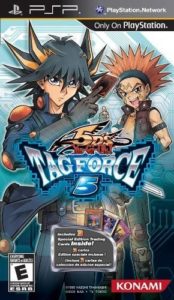 The final Tag Force game to be printed worldwide and in English, Tag Force 5 was released on October 26th, 2010 and gave us Fleur Synchron, Chevalier de Fleur, and Liberty at Last! for promos. Fleur Synchron is a Level 2 LIGHT Machine Tuner with 400/200 stats and lets you Special Summon a Level 2 or lower monster from your hand if sent to the graveyard for a Synchro Summon. A meh Tuner, being a Synchron it was a prime reprint for the Synchron Extreme Structure Deck on August 28th, 2015. Chevalier de Fleur is a Level 8 WIND Warrior Synchro of Fleur Synchron and any number of non-Tuners, has 2700/2300 stats, and once during each of your turns can negate the activation of your opponent’s Spell/Trap and destroy it. A decent option in early Synchron decks, this card has never seen a reprint since this game’s release. Liberty at Last! is a Normal Trap that targets and shuffles 2 face-up monsters on the field into the deck when a monster you control is destroyed by battle and sent to the graveyard. A fairy niche Trap, this card’s sole reprint came in Battle Pack: Epic Dawn on May 24th, 2012.
The final Tag Force game to be printed worldwide and in English, Tag Force 5 was released on October 26th, 2010 and gave us Fleur Synchron, Chevalier de Fleur, and Liberty at Last! for promos. Fleur Synchron is a Level 2 LIGHT Machine Tuner with 400/200 stats and lets you Special Summon a Level 2 or lower monster from your hand if sent to the graveyard for a Synchro Summon. A meh Tuner, being a Synchron it was a prime reprint for the Synchron Extreme Structure Deck on August 28th, 2015. Chevalier de Fleur is a Level 8 WIND Warrior Synchro of Fleur Synchron and any number of non-Tuners, has 2700/2300 stats, and once during each of your turns can negate the activation of your opponent’s Spell/Trap and destroy it. A decent option in early Synchron decks, this card has never seen a reprint since this game’s release. Liberty at Last! is a Normal Trap that targets and shuffles 2 face-up monsters on the field into the deck when a monster you control is destroyed by battle and sent to the graveyard. A fairy niche Trap, this card’s sole reprint came in Battle Pack: Epic Dawn on May 24th, 2012.
Fleur Synchron: 4 Years, 10 Months, and 2 Days between video game printing and first mass reprint.
Chevalier de Fleur: Never reprinted.
Liberty at Last!: 1 Year, 6 Months, and 28 Days between video game printing and first mass reprint.
Yu-Gi-Oh! 5D’s Duel Transer
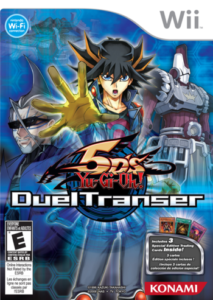 Another rare Wii game, Duel Transer was released on December 7th, 2010 and gave us Ape Fighter, Closed Forest, and Roaring Earth for promos. Ape Fighter is a Level 4 DARK Beast with 1900/1200 stats, gains 300 ATK when it destroys an opponent’s monster by battle, but the ATK gained by this effect returns to 0 during the End Phase of a turn it did not attack. Mostly a beater, this card was first reprinted in Battle Pack: Epic Dawn on May 24th, 2012. Closed Forest is a Field Spell that boosts all your Beasts by 100 ATK for each monster in your graveyard, prevents players from activating Field Spells while it is face-up on the field, and prevents players from activating Field Spells the turn it is destroyed. A very strong card against decks reliant on a Field Spell, this card was first reprinted in Astral Pack One on November 23rd, 2012 before getting its first mass reprint in Battle Pack 3: Monster League on July 31st, 2014. Roaring Earth is a Continuous Trap that gives your Beast monsters piercing and debuffs an opponent’s monster by 500 ATK/DEF when you deal damage with this effect. A pretty lackluster card for Beasts by 2010/2011 standards, this card was only reprinted in Legendary Collection 5D’s on October 23rd, 2014.
Another rare Wii game, Duel Transer was released on December 7th, 2010 and gave us Ape Fighter, Closed Forest, and Roaring Earth for promos. Ape Fighter is a Level 4 DARK Beast with 1900/1200 stats, gains 300 ATK when it destroys an opponent’s monster by battle, but the ATK gained by this effect returns to 0 during the End Phase of a turn it did not attack. Mostly a beater, this card was first reprinted in Battle Pack: Epic Dawn on May 24th, 2012. Closed Forest is a Field Spell that boosts all your Beasts by 100 ATK for each monster in your graveyard, prevents players from activating Field Spells while it is face-up on the field, and prevents players from activating Field Spells the turn it is destroyed. A very strong card against decks reliant on a Field Spell, this card was first reprinted in Astral Pack One on November 23rd, 2012 before getting its first mass reprint in Battle Pack 3: Monster League on July 31st, 2014. Roaring Earth is a Continuous Trap that gives your Beast monsters piercing and debuffs an opponent’s monster by 500 ATK/DEF when you deal damage with this effect. A pretty lackluster card for Beasts by 2010/2011 standards, this card was only reprinted in Legendary Collection 5D’s on October 23rd, 2014.
Ape Fighter: 1 Year, 5 Months, and 17 Days between video game printing and first mass reprint.
Closed Forest: 1 Year, 11 Months, and 16 Days between video game printing and first non-mass reprint and 3 Years, 7 Months, and 24 Days between video game printing and first mass reprint.
Roaring Earth: 3 Years, 10 Months, and 16 Days between video game printing and first mass reprint.
Yu-Gi-Oh! 5D’s World Championship 2011: Over the Nexus
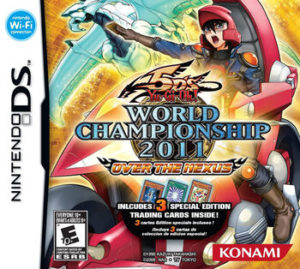 The last game for three years to give us video game promos, and the last of the World Championship series, Over the Nexus was released on May 10th, 2011 and gave us Necro Fleur, Sorciere de Fleur, and Z-ONE as promos. Necro Fleur is a Level 1 DARK Plant with 0/0 stats and Special Summons a Sorciere de Fleur from the deck if it is destroyed by a card effect. Sorciere de Fleur is a Level 8 DARK Spellcaster with 2900/0 stats and Special Summons a monster from your opponent’s graveyard to your side of the field as a hard once per turn, but said monster cannot attack and it is destroyed during the End Phase. Z-ONE is a Normal Spell that retrieves a Continuous or Field Spell from your graveyard to your hand when this set card is sent to the graveyard. Cards from an anime duel that was never dubbed and cards that weren’t really competitive, these cards were never reprinted outside this game.
The last game for three years to give us video game promos, and the last of the World Championship series, Over the Nexus was released on May 10th, 2011 and gave us Necro Fleur, Sorciere de Fleur, and Z-ONE as promos. Necro Fleur is a Level 1 DARK Plant with 0/0 stats and Special Summons a Sorciere de Fleur from the deck if it is destroyed by a card effect. Sorciere de Fleur is a Level 8 DARK Spellcaster with 2900/0 stats and Special Summons a monster from your opponent’s graveyard to your side of the field as a hard once per turn, but said monster cannot attack and it is destroyed during the End Phase. Z-ONE is a Normal Spell that retrieves a Continuous or Field Spell from your graveyard to your hand when this set card is sent to the graveyard. Cards from an anime duel that was never dubbed and cards that weren’t really competitive, these cards were never reprinted outside this game.
Necro Fleur, Sorciere de Fleur, and Z-ONE: Never reprinted.
Yu-Gi-Oh! ZEXAL World Duel Carnival
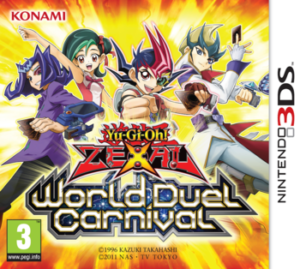 The lone game released under the ZEXAL banner, World Duel Carnival was released on June 26th, 2014 in Europe and gave us Snow Plow Hustle Rustle, Night Express Knight, and Special Schedule for promos. Snow Plow Hustle Rustle is a Level 10 EARTH Machine with 2500/3000 stats and if your opponent declares a direct attack while you have cards in your Spell/Trap zone, you can Special Summon this card from the hand, destroy as many of your Spells and Traps as possible, then burn the opponent for 200 damage for each card destroyed by this effect, and while you control this card you cannot Special Summon monsters except for Machines. Night Express Knight is a Level 10 EARTH Machine with 3000/3000 stats, cannot be Special Summoned from the deck, and can be Normal Summoned without tribute by having its original ATK become 0. Special Schedule is a Normal Spell that revives any Machine monster with 3000 or more ATK from your graveyard, you can only activate one a turn, and if this set card is destroyed and sent from the field to the graveyard, you can target a Machine in your graveyard and add it to your hand. Each having their own place in the Rank 10 Train deck, whether niche or staple, each of these were first reprinted in Dragons of Legend: Unleashed on August 18th, 2016.
The lone game released under the ZEXAL banner, World Duel Carnival was released on June 26th, 2014 in Europe and gave us Snow Plow Hustle Rustle, Night Express Knight, and Special Schedule for promos. Snow Plow Hustle Rustle is a Level 10 EARTH Machine with 2500/3000 stats and if your opponent declares a direct attack while you have cards in your Spell/Trap zone, you can Special Summon this card from the hand, destroy as many of your Spells and Traps as possible, then burn the opponent for 200 damage for each card destroyed by this effect, and while you control this card you cannot Special Summon monsters except for Machines. Night Express Knight is a Level 10 EARTH Machine with 3000/3000 stats, cannot be Special Summoned from the deck, and can be Normal Summoned without tribute by having its original ATK become 0. Special Schedule is a Normal Spell that revives any Machine monster with 3000 or more ATK from your graveyard, you can only activate one a turn, and if this set card is destroyed and sent from the field to the graveyard, you can target a Machine in your graveyard and add it to your hand. Each having their own place in the Rank 10 Train deck, whether niche or staple, each of these were first reprinted in Dragons of Legend: Unleashed on August 18th, 2016.
Snow Plow Hustle Rustle, Night Express Knight, and Special Schedule: 2 Years, 1 Month, and 23 Days between video game printings and first mass reprints.
In Conclusion
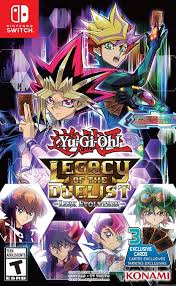 Now for the statistics for each of these video game promos, not counting the ones in Legacy of the Duelist: Link Evolution since that just came out. Out of the 98 promos listed, 79 of them have received a mass reprint (a 83.16% rate of being reprinted) and on average, these promos have taken about 5 Years to receive their first mass reprint (adjusted for error). Also out of the 98 promos, 23 of them got their first reprint in a Tournament Pack like set (a 23.31% rate of being reprinted) and on average, it takes about 3 and a half to 4 Years to get a non-mass reprint like this (adjusted for error). Only two games listed have all promos released with the game not be reprinted in other sets (Wheelie Breakers and World Championship 2011). Out of all these cards, only two of them have received reprints in Tournament Packs, but no mass reprints (Helios Duo Megistus and Fairy King Truesdale). With this, 81 of the 98 cards have been reprinted and 17 have not. The shortest time between the video game printing and first mass reprint is 6 Months and 19 Days (Dark Sage) while the longest we’ve waited was 14 Years, 8 Months, and 27 Days (Sword of Dragon’s Soul). I do notice sometimes that promos do get reprinted quicker if they were iconic from the anime and/or the archetypes the support is getting new pieces of support released around the times of the reprints, so that’s worth noting. There were also a lot of repeat sets for promo reprints like in Legendary Collections and Battle Packs, while others are scattered around in Structure Decks and reprint sets. Now, I can imagine Micro Coder, Cynet Codec, and Progleo not taking 5 Years for a reprint, and I imagine the first reprints for each would be mass reprints, but I wouldn’t be shocked if it took a few years for them to be reprinted as well. This article is just meant to give you an idea of the average time for promo reprints, the likelihood of cards being reprinted en mass or in a Tournament Pack, and the best/worst care scenarios for time we have to wait for promo reprints. All of this data could change if some of these cards that were never reprinted finally get their reprints, and I do imagine there will be the day where that happens, but just know that you shouldn’t be surprised if you have to wait a few years for promos to get reprinted, because some are still waiting for reprints after anywhere between 8 and 15 Years.
Now for the statistics for each of these video game promos, not counting the ones in Legacy of the Duelist: Link Evolution since that just came out. Out of the 98 promos listed, 79 of them have received a mass reprint (a 83.16% rate of being reprinted) and on average, these promos have taken about 5 Years to receive their first mass reprint (adjusted for error). Also out of the 98 promos, 23 of them got their first reprint in a Tournament Pack like set (a 23.31% rate of being reprinted) and on average, it takes about 3 and a half to 4 Years to get a non-mass reprint like this (adjusted for error). Only two games listed have all promos released with the game not be reprinted in other sets (Wheelie Breakers and World Championship 2011). Out of all these cards, only two of them have received reprints in Tournament Packs, but no mass reprints (Helios Duo Megistus and Fairy King Truesdale). With this, 81 of the 98 cards have been reprinted and 17 have not. The shortest time between the video game printing and first mass reprint is 6 Months and 19 Days (Dark Sage) while the longest we’ve waited was 14 Years, 8 Months, and 27 Days (Sword of Dragon’s Soul). I do notice sometimes that promos do get reprinted quicker if they were iconic from the anime and/or the archetypes the support is getting new pieces of support released around the times of the reprints, so that’s worth noting. There were also a lot of repeat sets for promo reprints like in Legendary Collections and Battle Packs, while others are scattered around in Structure Decks and reprint sets. Now, I can imagine Micro Coder, Cynet Codec, and Progleo not taking 5 Years for a reprint, and I imagine the first reprints for each would be mass reprints, but I wouldn’t be shocked if it took a few years for them to be reprinted as well. This article is just meant to give you an idea of the average time for promo reprints, the likelihood of cards being reprinted en mass or in a Tournament Pack, and the best/worst care scenarios for time we have to wait for promo reprints. All of this data could change if some of these cards that were never reprinted finally get their reprints, and I do imagine there will be the day where that happens, but just know that you shouldn’t be surprised if you have to wait a few years for promos to get reprinted, because some are still waiting for reprints after anywhere between 8 and 15 Years.
Thanks for Reading,
Crunch$G

